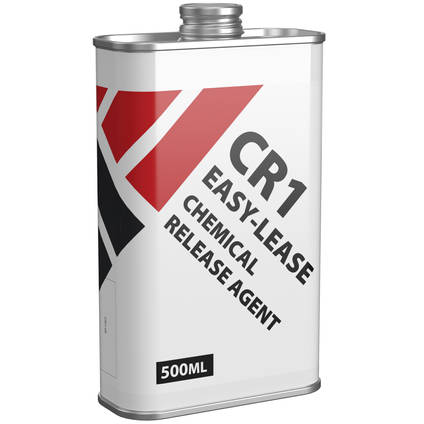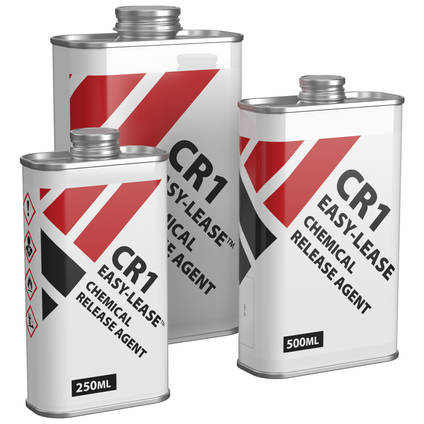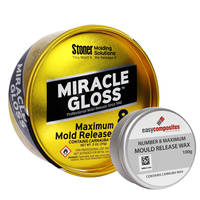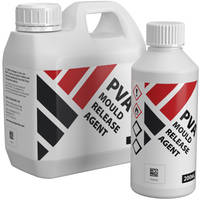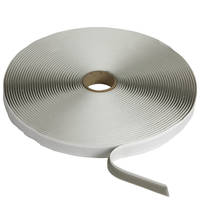Need any help or advice?+44 (0)1782 454499
Downloads (3)
This is a chemical product. Before storage or use you must download and read the accompanying safety and technical datasheets.
| Safety Datasheet (SDS) | ||
| Dutch Safety DataSheet | ||
| Technical Datasheet (TDS) |
Specification
Product Data
| Shelf Life | 12 | Months |
|---|---|---|
| Max Service Temp | 175 | °C |
General Properties
| Gross Weight | 0.5 | kg |
|---|
Shipping Information
Restrictions
In the currently selected pack size, this product is classed as dangerous goods in limited quantity for the purposes of transport.
Shipping is possible to all UK addresses, including the Channel Islands, without restriction. However, due to being classed as 'dangerous goods', delivery times are not guaranteed on any delivery service.
Shipping to EU countries is now done through our European subsidiary based in the Netherlands. All EU customers should use www.easycomposites.eu.
To check availability of shipping to any other country, add the item to your basket and use the shipping calculator on the basket page.
For a full information regarding the shipment of dangerous goods to all destinations, see our delivery information page.
Package Size
There are no package size restrictions or surcharges for this product.
Delivery Cost
To find the availability and cost for delivery of this item to your address, add it to your basket and then use the instant shipping calculator on the basket page.
CR1 Easy-Lease Chemical Release Agent
- CR1-05
Hazardous
- 4.5/5 Average rating
The ultimate in semi-permanent chemical release agents. Use CR1 Easy-Lease to prevent moulds sticking to patterns and components sticking to moulds. Compatible with nearly all tool surfaces, cure temperatures and resin systems including epoxy, polyester and vinylester. Suitable for wet-lay, resin infusion, and pre-preg use; both in and out of autoclave.
Available to buy online in 250ml, 500ml and 1l tins.
PRODUCT VERSIONS
Pack Size
AVAILABILITY:More than 10 availablefor immediate shipping
We won’t be beaten on price!
If you believe you’re buying an equivalent product cheaper elsewhere, contact us to discuss your requirements.
CR1 Easy-Lease™ Chemical Release Agent is the ultimate blend in semi-permanent release agents; it provides exceptional sealing and release properties over a huge range of resins and mould materials. With a simple and forgiving application resulting in ultra-low build-up and high-gloss qualities, it is the one-stop release agent solution for advanced composite manufacturing.
Typical Uses
With the exception of silicone rubber and materials subject to solvent attack CR1 Easy-Lease™ Release Agent will work with many combinations of materials, however, we would always advise testing any new resin/mould material combination on a small sample before committing to a full moulding.
CR1 Easy-Lease™ will not release polyurethane resins.
How to Buy
CR1 Easy-Lease Chemical Release Agent is available in a handy 250ml can, 500ml can or a full 1l can.
Choose the pack size you require from the drop-down list at the top of the page.
Further Information
Application Guide
After preparing the mould surface with MC1 Mould Cleaner apply the CR1 Easy-Lease Chemical Release Agent in a thin film over the surface of the mould using a small piece of lint-free cloth.
Unlike many other chemical release systems CR1 Easy-Lease does not require the use of a separate mould sealer prior to application; providing ultimate reliability and simplicity.
Once the film begins to evaporate (5-30 seconds) use a second piece of cloth lightly in a circular motion to remove the excess and even-out the film.
On a new mould apply 6 coats leaving a minimum of 15mins between each application. Leave the final coat for at least 1 hour before using the mould.
Note: Large mould surfaces may need to be done in stages to avoid evaporation, depending upon working temperature and mould complexity around 0.5sqm should be considered the maximum area per application.
CR1 Easy-Lease Chemical Release Agent is a semi-permanent release agent meaning it is capable of multiple releases. For ambient temperature operations using normal resins and mould surfaces 5-10 'pulls' from a mould should be expected. As soon as there are any signs of the release quality diminishing re-apply one coat to restore the performance
Because this release agent is very fast and simple to apply, for very complicated parts, or more aggressive processes such as prepreg and resin infusion, we would advise applying a coat between every release.
- All standard resins and gel-coats, polyester, vinyl ester, epoxy etc.
- All standard tool surfaces; epoxy, PU, polyester, vinyl ester, aluminium, stainless steel, glass, prepregs etc.
- Suitable for use in elevated temperature curing processes up to 175°C e.g. prepreg and oven curing.
CR1 Easy-Lease™ Chemical Release Agent is the ultimate blend in semi-permanent release agents; it provides exceptional sealing and release properties over a huge range of resins and mould materials. With a simple and forgiving application resulting in ultra-low build-up and high-gloss qualities, it is the one-stop release agent solution for advanced composite manufacturing.
Typical Uses
With the exception of silicone rubber and materials subject to solvent attack CR1 Easy-Lease™ Release Agent will work with many combinations of materials, however, we would always advise testing any new resin/mould material combination on a small sample before committing to a full moulding.
CR1 Easy-Lease™ will not release polyurethane resins.
How to Buy
CR1 Easy-Lease Chemical Release Agent is available in a handy 250ml can, 500ml can or a full 1l can.
Choose the pack size you require from the drop-down list at the top of the page.
Further Information
Application Guide
After preparing the mould surface with MC1 Mould Cleaner apply the CR1 Easy-Lease Chemical Release Agent in a thin film over the surface of the mould using a small piece of lint-free cloth.
Unlike many other chemical release systems CR1 Easy-Lease does not require the use of a separate mould sealer prior to application; providing ultimate reliability and simplicity.
Once the film begins to evaporate (5-30 seconds) use a second piece of cloth lightly in a circular motion to remove the excess and even-out the film.
On a new mould apply 6 coats leaving a minimum of 15mins between each application. Leave the final coat for at least 1 hour before using the mould.
Note: Large mould surfaces may need to be done in stages to avoid evaporation, depending upon working temperature and mould complexity around 0.5sqm should be considered the maximum area per application.
CR1 Easy-Lease Chemical Release Agent is a semi-permanent release agent meaning it is capable of multiple releases. For ambient temperature operations using normal resins and mould surfaces 5-10 'pulls' from a mould should be expected. As soon as there are any signs of the release quality diminishing re-apply one coat to restore the performance
Because this release agent is very fast and simple to apply, for very complicated parts, or more aggressive processes such as prepreg and resin infusion, we would advise applying a coat between every release.
- All standard resins and gel-coats, polyester, vinyl ester, epoxy etc.
- All standard tool surfaces; epoxy, PU, polyester, vinyl ester, aluminium, stainless steel, glass, prepregs etc.
- Suitable for use in elevated temperature curing processes up to 175°C e.g. prepreg and oven curing.
Specification
Product Data
| Shelf Life | 12 | Months |
|---|---|---|
| Max Service Temp | 175 | °C |
General Properties
| Gross Weight | 0.5 | kg |
|---|
Haziness on the surface of your parts sounds like over-application of release agent. You'll get it on the mould if you have over-applied release agent to the pattern which would then need polishing out of the mould and then if you over-apply it again onto the mould then it will come back and then also be reproduced through onto your finished parts. It's a careful balance with release agents; they do ‘build’ which means they leave a deposit on the surface of the mould. The trick is to apply then thinly but smoothly; we sometimes use a bit of a wipe on/wipe off technique to avoid this visibly build up. A light buff (this is where you need to be careful!) immediately after you apply it will prevent this but you need to make sure that you’re not taking it all away. With the right technique you can have a perfect gloss from the mould but at first it’s very easy to have too much build up which causes the haziness.
CR1 isn't compatible with silicone rubbers or surfaces that would be softened by solvents, so you have to be careful with painted surfaces. Additionally, it's not suitable for use with polyurethane resins.
The majority of mould surface are fine with CR1, although resin doesn't stick to materials like polypropylene so you can usually get away without the need for any release agent.
As always, we would recommend doing a small test with the material and the resin you intend to use to ensure that there are no issues.
In order to remove smears and improve the gloss, it is possible to 'buff' each application of Easy-Lease just after it dries however this is a process that needs to be done carefully to ensure that you don't remove the Easy-Lease. Due to the fact that it does require some experience and control to get right, we would suggest you practice this technique on a non-critical part (like a small sheet of glass) to ensure that you are still left with a surface that release well.
The process would be to start by 'buffing' the surface from any previous applications of release agent using a clean microfibre (or similar) lint-free cloth. The surface needs to be glossy and smear-free before you proceed. Next, apply a coat of Easy-Lease, wait a minute or so for it to just dry, then buff very lightly with a clean cloth until the smears are gone. Wait 15 minutes then repeat as normal, building up 4-5 coats of release agent, each one buffed around a minute after application.
A I mentioned, if your buffing action is too strong, it is possible to remove each application of release agent instead of just buffing out the smears and so you should practice with this technique to ensure you're still getting a reliable release before using it on a critical moulding.
Epoxy resin will naturally release from PETG so it is not actually necessary to use a release agent. However, use of a release agent, like Easy-Lease (CR1) will make the surface more 'slippy' and aid the release.
Easy-Lease has almost zero 'build' however and so the surface on your mould will be the surface that you get on your parts, therefore, the smoother you can leave the mould the better and so it's absolutely fine to continue right up to a P1200 finish. There's no need to worry about the CR1 bonding to the PETG, it doesn't need a 'key' in this way.
Indeed, yes, acetone can be a big aggressive on composite moulds although, if they're epoxy and you're seeing acetone affect the surface then that can be an indication that the mould is not fully, fully cured.
That said, a better solution which is not only less aggressive but actually more effective at removing contamination, including release agent, from the surface of a mould would be our MC1 Mould Cleaner. The listing shows that it can be used before release agent application but it can also be used to remove release agent, wax, or other surface treatments.
Yes, Mould Cleaner will strip off all release agents during the process of cleaning the mould. This means it is essential to re-apply Easy-Lease prior to using the mould again.
It is possible to use Easy-Lease to seal and improve the surface of the PU240 board however the amount of 'build' from each application of Easy-Lease is tiny and so a huge number of applications and drying cycles would be necessary. For this reason, it would normally be more effective (and certainly quicker) to use a proper board sealer such as our S120 Board Sealer which is much higher build and will therefore seal and surface the board more effectively. After using the board sealer, you will need to do some flatting and polishing to take the surface up to a smooth gloss.
Depending on the standard of the finish after machining, another product that could also be used to seal and surface the PU240 board would be either our Pattern Coat Primer or Pattern Coat Hi Gloss. Both of these products are considerably faster building than the S120 Board Sealer and so would could be suitable if you have a coarser finish after machining which would benefit from a higher build coating prior to flatting/polishing which would allow the surface to be worked more.
Yes, Easy Lease could be used either as a release agent on a phenolic mould or to release phenolic resins from a mould.
Easy-Lease is extremely unlikely to cause any harm to the mould surface. It can add a bit of gloss to a surface when multiple coats are added. However, this can be easily removed once you have finished using our Easy-Lease Mould Cleaner which will remove all traces of release agent as well as any other dirt or contaminants from the component surface.
It is possible to use chemical release agent with a wooden (timber) mould however you would need to do something to thoroughly seal the wood beforehand, the release agent on its own would not be sufficient to do this.
One 'high tech' solution would be to use a high-build mould sealer like our S120 Board Sealer which could be sprayed or wiped onto the wood to seal it; multiple applications would be required but once complete you would have effectively given your wood a plastic coating. At the other end of the technology (and cost) spectrum would be to use something like shellac sanding sealer. This would be available from timber merchants and good DIY stores and we have heard of a number of customers successfully sealing timber with shellac before using chemical release agent on it but you would need to experiment with this and make sure that you had fully and properly sealed the wood - you would probably need 10+ coats of shellac to do this.
An alternative to sealing the wood with a conventional sealer would be to instead coat it using a resin such as our Pattern Coat Primer. This is probably the fastest and most cost effective solution, especially if you can spray the primer.
Once you've followed one of the above methods then you can use Easy-Lease on a wooden mould in just the same way as you would on any other substrate.
For cleaning up spillages and general cleaning of mould surfaces we would recommend acetone.
And also, how do you clean pulled parts to prep for paint--Easy-Lease mold cleaner?
Yes, generally (depending on material your pattern is made from and the resin you're making your mould from) we suggest Easy-Lease release agent when going from pattern-to-mould and then from mould-to-component.
In many of our tutorial videos you'll notice that we go for a safe-not-sorry approach of applying Easy-Lease to the pattern (5 layers as per guidance) and then we use multiple applications of mould release wax over the top of the release agent. This means that when we separate the pattern and the mould, the parting actually happens between the wax and the release agent.
To remove traces of release agent prior to paint we normally use acetone before keying the surface with an abrasive paper or Scotch pad.
For most moulds, application by lint-free wipe is the recommended process however for very large moulds is it possible to spray Easy-Lease. If you do choose to spray Easy-Lease then the correct standard of respiratory protection and correctly set-up ventilation/extraction would be required.
I'm making a pattern with a view to producing a wet lay polyester glass mould. I'd like to use Maguires #8 wax to give the pattern a decent gloss finish, does it make sense to use easy lease on top of the wax to improve the release characteristics? The pattern has a Pattern Coat primer finish.
Definitely DON'T do this! I fully understand the reason for asking however if you apply Easy-Lease over the top of wax then the solvent in the Easy-Lease will lift the wax and mingle with it resulting in neither a wax barrier that works or an Easy-Lease barrier that works.
If you're making a polyester mould off a polyester pattern and you want to improve the finish of the pattern using wax (rather than really polishing up the Pattern-Coat Primer) then you should be fine to just use the Maguire's wax on its own. It will provide a perfectly reliable release barrier and, as you say, will add further gloss to the pattern. The alternative would be to do further polishing on the pattern (or use the Pattern Coat Hi-Gloss) and then use only Easy-Lease Chemical Release Agent. Whatever you do, don't use wax first then Easy-Lease.
Yes, brushes used with Easy-Lease can be easily cleaned with acetone. Such brushes should be allowed to fully dry out before re-use.
No, Easy-Lease is a semi-permanent release agent so can be left of the mould between releases. Generally, for each release we would suggest adding a new application of the release agent however in many situations it is not necessary; for example when working with polyester resins, you will often get 10+ releases from the Easy-Lease before a single new application is required. If you're working with more aggressive processes, like prepreg, then re-applying the Easy-Lease between each release is recommended.
Easy-Lease is a substitute for any other type of release agent so you don't need to use anything else like wax or PVA. The normal way to use the release agent is multiple applications straight onto a clean mould and then yoiu can use the mould. It's semi-permenant so you don't need to re-apply each time, only if the parts start to grip in the mould slightly.
Easy-Lease Chemical Release Agent is likely to be transferred to the part surface during lamination. Failure to remove the release agent from the bonding surface is likely to lead to a failure of the bond or a very weak bond. To achieve a good bond to a composite part, we always recommend a good key, clean and degrease which will prepare the surface for bonding as well as removing any traces of release agent or other contaminants from the bonding surface.
ASK YOUR OWN QUESTION
Customer Product Reviews for CR1 Easy-Lease Chemical Release Agent
It's the best release agent i've ever used! Excellent result!
I have never used a 'Chemical Release Agent' before but had seen good things about this stuff... I applied it over an epoxy based plug. I was concerned at the plug was about 1.8 Sqm in area with allot of complex geometry with draft angle as low as 0.5 degrees... I put in a wedge in a corner and applied a slight twist and the whole mould popped straight off! Brilliant Stuff! Wont be using anything else from now on.
This is my go-to release agent. I've never had any issues with it, even on large molds with almost parallel sides.
I wanted to say that your easy lease release agent is probably one of the best I’ve ever used. Thank you!
Easy to apply and works very well.
SUBMIT YOUR OWN PRODUCT REVIEW
We publish all reviews for verified purchases. Submit your own review and help other customers with their choices.SUBMIT YOUR OWN PRODUCT REVIEW
We publish all reviews for verified purchases. Submit your own review and help other customers with their choices.Shipping Information
Restrictions
In the currently selected pack size, this product is classed as dangerous goods in limited quantity for the purposes of transport.
Shipping is possible to all UK addresses, including the Channel Islands, without restriction. However, due to being classed as 'dangerous goods', delivery times are not guaranteed on any delivery service.
Shipping to EU countries is now done through our European subsidiary based in the Netherlands. All EU customers should use www.easycomposites.eu.
To check availability of shipping to any other country, add the item to your basket and use the shipping calculator on the basket page.
For a full information regarding the shipment of dangerous goods to all destinations, see our delivery information page.
Package Size
There are no package size restrictions or surcharges for this product.
Delivery Cost
To find the availability and cost for delivery of this item to your address, add it to your basket and then use the instant shipping calculator on the basket page.
RELATED PRODUCTS
CUSTOMERS ALSO PURCHASED
RELATED PRODUCTS
CUSTOMERS ALSO PURCHASED
100% SECURE
PAYMENT METHODS


Easy Composites Ltd, registered in England 7486797. All content copyright (C) Easy Composites Ltd, 2025. All rights reserved.
